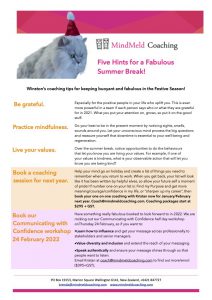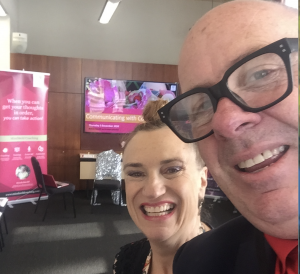Category Archives: Leadership
We love what we do – 2021 is on!
We are so happy it’s 2021 and we have no problem being back at work because we love what we do – which is helping your magnificent selves be even more fabulous at work!
Here’s what we did on our holidays; hung out with friends and family, drank kale juices, jumped off a jetty, read books, gave crazy Christmas presents, op-shopped, and downloaded Bridgerton but haven’t got round to watching it yet.
We hope your holidays were just as invigorating/relaxing, whatever is right for you. The break certainly helped us reflect on how lucky we are to live here in Aotearoa NZ, and we feel super-thankful for that, while knowing that there are further challenges ahead.
Doing a smidge of strategic planning this morning, what we learned from last year is that creativity and bravery are the way to go in business. Thank you all who allowed us to share our resilience tools and bring our full sparkliness to coaching and workshops (that genie is not going back in the bottle).
People have asked us about our goals for this year. Here they are.
We want to look back on now from five years time, and know we did our best to be kind, helpful, generous, responsible, expansive and caring. That we rocked out our MindMeld Values to the max (Creativity, Results, Abundance, Delightful, Professional and Honesty). We all have something going on in our lives and so compassion and reassuring ourselves of our own ‘enuf-ness’ is the way to go in 2021.
On these hot days at work, wiggle your toes under your desk, and get ready – 2021 is on!
Be Fabulous Online!
Tips and Tricks for Building Online Meeting Rapport
Over the last few weeks, we have all been becoming more skilled with facilitating meetings via a variety of on-line platforms. You’ve mastered booking meetings on line, sharing data, and having online drinkies after work. Nice! We have felt our collective neurons growing as we have all learned these new skills.
At MindMeld we love facilitating meetings, and have been tweaking our face-to-face style to continue to provide that lovely rapport-building between participants that makes for rich and productive conversations. Rapport is important for your team to feel engaged and connected in a time of change.
If you are anything like us, you have got used to this new online way of working (kind of), and are wondering how to keep the new adaptability and good things going forward (‘work tops/trackie bottoms’).
Kristan and Brenda rocking out a resilience webinar – sci-fi themed for added engagement!
Follow these tips to keep your team-building gains, and set your team up for success when you are all back working face-to-face.
- Sit on top of your router, (well not literally, that’s a bit uncomfortable). But sit as close as you can to reduce buffering and your screen freezing.
- Do a practice meeting with yourself to see what you look like on screen. If you have a Photo Booth function then you can check your background for a professional look, and adjust your screen tilt to reduce the ‘up the nostril’ shot or extra chins.
- Speak in short sentences, with one point per sentence, so that all participants can hear your message.
- Keep your agenda short. Facilitating workshops online is tiring for you and the participants.
- Give a ‘head and heart’ goal at the beginning of the meeting. This means be clear on what you want to get out of the meeting (head goal), and how you want people to feel such as connected and included (heart goal).
- Smile and nod. Normally we would read the body language of others in the room, but that is not so easy online as we can’t see their whole body – we can only see their head and shoulders. Nodding is an unconscious reflex, which demonstrates you have heard the other person, and gives other participants the confidence to speak. If you are not sure when to nod, then nod at the end of the other person’s sentence. This helps you look authoritative and not like a nodding dog in the back of the car.
- Ask questions! A great way to ask questions, is to start with the person’s name (to let them know a question is coming), followed by an open question, such as: “Kristan what is your view on what we have discussed?”This pre-supposes that Kristan has a question. If you ask: “Kristan, do you have a question?”, then he can answer “Yes” or “No”, and you have a 50% chance of him shaking his head – ‘Nek minute’, dead air.
- Pop yourself on mute when you are not speaking. Heavy breathing while listening can be picked up your computer and switch the speaker’s screen to your screen, which disrupts the flow.

- Winston our Coach Cat makes this ‘Open the fridge now’ face during every meeting. Your pet will sense you are busy online and will try to get your attention any way they can. Our cat Winston is a shocker for demanding food loudly, and walking across the keyboard. That’s OK, people like to see pets. But don’t let your pet knock a glass of water over your computer. [Advice from Kristan, based on real-life events from last Thursday’s workshop.]
- Headphones work to cut down on any unwanted background household noise from being transmitted to your colleagues. If you have noise-cancelling headphones, use them, they are amazing.
- Remember all the good processes you normally use in meetings to make them go well, and do them! If you open and close with a karakia and waiata, that is fantastic, and still do those things.
Finally, don’t be afraid to create new rituals that work for you and your team! We’ve been ending workshops with an inspirational quote (pictured), which can also be used as a mantra.
A little bit more on body language and rapport.
Albert Mehrabian found in his research that when people are together and talking about their feelings in a situation, emotional meaning is communicated:
- 7 percent through actual words used. Head goal and heart goal.
- 38 percent through the voice — tone, speed. Short sentences, and openquestions.
- 55 percent through body language — gesture, posture, facial expressions. Nodding at the end of the sentence, smiling.
References
• John Gottman, The Gottman Institute, www.gottman.com and The Seven Principles of Making Marriage Work. (2000) . • Albert Mehrabian, Silent Messages: Implicit Communication of Emotions and Attitudes (2nd ed.) (1981).
Worry WART Tool – Worrying Within Approved Rumination Times
Worrying Within Approved Rumination Times in the Tardis
Here’s short clip showing you how to decrease worries, by scheduling a specific time to worry.
Identify a time to have a meeting with yourself so you can worry about the situation flat out for 30 Minutes (actually shorter time works just as well). Then if you think about this issue outside your Worry WART time, all yourself you will give this issue your full attention later. This tricks your brain and frees up your thoughts for more useful tasks.
Spoiler alert! What you will find is that by the time it comes for you to have your meeting, you will have forgotten about it, or you can’t focus on that worry, and choose to do something else.
The Extrovert’s Guide to Working From Home

At MindMeld, I have been working from home for the past eight years, and Kristan for the last three years. We know a lot about working from home, but it wasn’t until this week when several people starting asking me about it, that I realised how much Kristan and I know about how to function effectively when working from home, in terms of practical tips, how to manage emotions, and stay connected with colleagues.
We are both extroverts. I need a lot of people contacts per day, otherwise, my emotional and physical energy gets low. Our MindMeld Purpose is all to do with helping people through coaching and workshops, so I need to be around people to feel on purpose in my work. We have strategies that keep our focus and energy up as we work from home and want to share them with you. Please feel free to adapt them in a way that works for you, the working from home requirements of your agency, and of course, complying with any legislative and Ministry of Health requirements.
Our office is affectionately known as ‘The TARDIS’, as it is decorated to reflect Dr Who, one of our favourite Sci-Fi TV shows. Working from home is probably hardest for me when it is raining, cold, and everyone is home for the school holidays. Dishes pile up, Winston our cat will get his fur wet and muddy, and then he smells a bit like an old sheep. That’s when he will sit on me or on my keyboard. Family interrupts because they are bored or hungry. Be compassionate to yourself and to them. You will get interrupted a lot, so roll with that.
Here are the three qualities that we think are the most important in working from home:
Time Management – Goal setting – Self management
Time Management
Work out your most creative period. For me, that’s in the morning. Inspiration can strike any time from 5.30 a.m. onward, and I know I am at my best designing coaching tools and handouts till about noon. I try to protect this time (and also be really quiet so I don’t wake up everyone) and will resist texting or interruptions as much as I can. I have ‘meetings with myself’ in my diary so that my colleagues know I am working on something important and give me that space. It also helps with the little dopamine hits in my brain of having achieved something that day. Then I really want to be with people in the afternoon. That’s when I hold coaching sessions (face to face while we still can otherwise it’s online), and also have phone and Zoom meetings.
Having a routine helps you achieve your work and balance demands from home. Decide a start and finish time, and stick to them. Close the door when you finish.
Goal setting
What must I do today? What would I like to achieve?
I work that out and start with my ‘must dos’’. If I feel a bit overwhelmed with a lot of must do’s, I begin with the task I have the most energy and enthusiasm for and as this gets my brain going for the other tasks. I find this works better than doing a whole lot of ‘shoulds’, as this can spark ideas, and I find life just goes better this way.
Self management
Skype coffees
I can get lonely working from home, and have some good strategies in place to deal with that. ‘Skype coffees’, where colleagues or friends make a coffee at their place, and then we go online and drink them together. I try to be upbeat and positive when having these kinds of meetings so that we energise each other.
Inspiring yourself
Make a playlist of music that helps you think and is uplifting. Doing a little dance in the office is energising and fun. [Check this out for some fun moves Never Stop Dancing NZ] I also bring other people into the office virtually, as I am very fond of audiobooks (check out Overdrive or your public library where you can download loads of great audio and e-books for free). I have the audiobooks running when I am tidying or filing because I really need motivating to do that!
We also have a couple of funny YouTube clips or inspiring speaker clips that might be 2 minutes long that provide a bit of boost and I might call them up if I need a bit of connection or cheering up. Here they are: Megan Rapinoe co-captain US soccer team speech excerpts; Animal Odd Couple Man who has a buffalo living in his house.
On the wall above your computer screen, create a collage of people you love and things you love to do, plus mantras to see you through. We also have our operating model on the wall in front of us to help guide decisions and remember our values. Decorating the wall in front of you with important reminders is really helpful, and your online guests won’t be able to see it.
Managing your thoughts
If I am home alone for too long, I find it hard to be confident in decisions and things might bug me that wouldn’t normally, and I become guilty believing my own thoughts and judging a situation. One of my best coaching tools is to do some inquiry and ask myself ‘Is this really true?‘ “Could there be another reason for this?’ and take a breath before responding. If we don’t have people in front of us, we are missing the vital clues to motivational behaviour that their body language provides. When we can only go by what they write in their emails, it’s so easy to feel triggered. I stop and think, ‘What is their positive intention underpinning their message?’ That helps with perspective.
Working from home requires a lot of compassion because your people aren’t in front of you but their emails are. I find taking my time to answer is really helpful. Kristan says “Check yourself before you wreck yourself”
Managing your home
The washing!!! Many people say they can’t work effectively from home if the house is a bit messy or there is something about the house that needs attention. You wouldn’t be late to work because you needed to fold all the washing, would you? Do the housework until your normal work start time, and then you can complete it once the day is over. One of the benefits of working from home though, is that you can bring the washing in if it starts to rain – very handy in Wellington.
I can stand in front of the fridge or pantry willing it to be full of yummy snacks. This comes from boredom. Try and eat healthy snacks instead. I find having my office at the bottom of the garden very handy in keeping me away from the fridge.
Getting ready to work from home
Get your home office or working space ready before you need it.
If you can, decide a dedicated space that is separate from other household activities. This includes important supplies such as printer ink, paper, and also tea and coffee, as well as complying with all your employer’s requirements for secure and confidential distance working. A lockable filing cabinet is also handy so everything is secure if you do have paperwork (think Privacy Act and also Healthy and Safety).
Sort out your wifi and invest in a wifi booster.
Nothing like trying to have an online meeting when someone else in the house is sucking down all the wifi for Netflix or downloading a giant game. This does not lead to harmony when working from home!
Practice using the online meeting tools
Have a trial go on your computer with Skype, FaceTime or Zoom, so you know how to work it. It’s very frustrating for others if they are waiting for you to join a conversation because you didn’t realise that it takes longer than you think.
Have a practice online meeting with a friend and ask them to check what they can see of your working space behind you. You want to appear tidy and you don’t want your fellow Skyper to see a mess, or photos or artworks you consider, ahem, private. They can give you feedback on how you place your screen so that they see your face and not your chins, up your nose, or the top of your head.
When you are on a call like this, people can still see and hear you, even if you don’t think they can, or you forget they can. I have seen people clearly do other work, scratch, pick their nose, and even walk away from a Zoom meeting because they forget people can see them.
A mantra
My mantra right now is ‘Face Everything And Rise’. I also love this quote from Lao Tzu, to help all of us as we head to working from home. “I have just three things to teach: simplicity, patience, compassion. These three are your greatest treasures.”
Finding your next role in times of change

How coaching can help you tap into your inner wisdom for empowering career choices
The traditional approach to finding your next role
When people think about their next career move, they often look for roles which they know they can do, and will provide a step along an existing career path. They go through job agencies or look at existing advertised roles, decide to apply, and then enter the formal recruitment process. This is a perfectly valid approach, and is an important part of job-seeking. It can be greatly beneficial when you connect with many expert recruiters we have in New Zealand. However there are drawbacks if you use only this approach to find your next role. The drawbacks are:
- It is passive – a person waits for an advertised role, and allows other people to reject or accept them. This creates feelings of ‘stuckness’ and even powerlessness in some people.
- It is competitive, which adds an extra element of stress during times of change.
- It takes people down a path they are already on, which reduces opportunities to grow and maximise skills – without realising it, people get more of the same, which includes both the things they liked and didn’t like about their past roles.
- It reinforces the artificial separation of work/life.
- It creates confusion in people who are good at many things, as it means they can perform a wide variety of roles. This can put them out of touch with what they truly want as part of a fulfilling career.
In short, it is old fashioned to just wait and apply for roles. It disadvantages you. There is so much more you can do to get the job and life you want, while you are waiting for those roles to come up. This is where support from a coach can help you. Continue reading
Are you an approval junkie? Five fast things you can do to curb your approval cravings
Losing your need for approval is one of the biggest things you can do to become more authentic and to live your life on purpose. As I write this, my cat Winston, is keeping me company, and is a continuing source of feline inspiration. When I look at my cat, I can see he totally doesn’t care what others think of him. He knows he is perfect just as he is – clearly.
The Relationship between Leadership, Charisma, Power and Integrity
In 2006 I journeyed to Stanford University as part of a fellowship to study the relationship between leadership and power. I say ‘journeyed’ because that is what the experience felt like – by the end of it I felt like a weary traveller who had battled many monsters and looked into the abyss. However, like many hero’s journeys, I came back with treasure, namely, what are the behaviours that can be learned that will help us become more powerful? And the central truth from my travels was that we become more powerful by making others more powerful. So how could I do that, in a way that enriches the greater good?
What’s Happening in the World of Collaboration?

Leadership collaboration can be defined as forming and preserving those critical business relationships and interpersonal connections that are outside formal hierarchical systems. Collaborative activities lie on the continuum between providing information and devolved decision making. Collaboration can occur within agencies, between agencies and across sectors.








